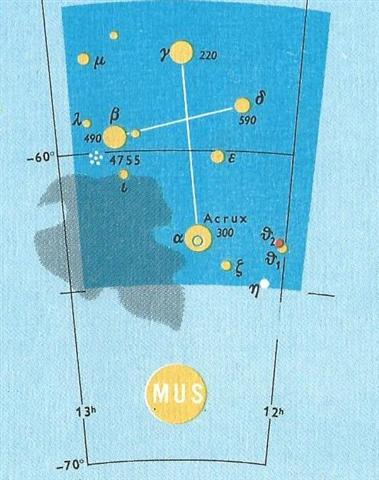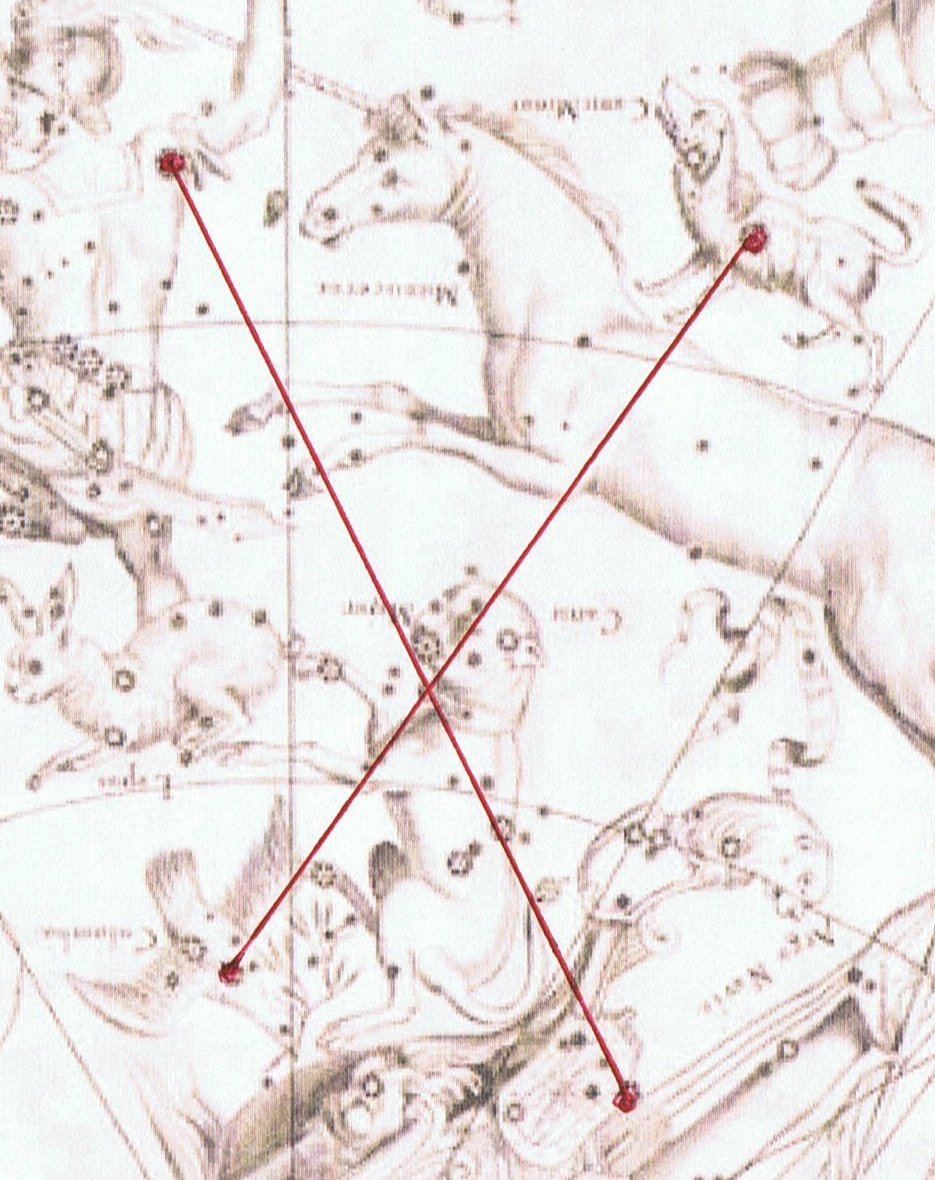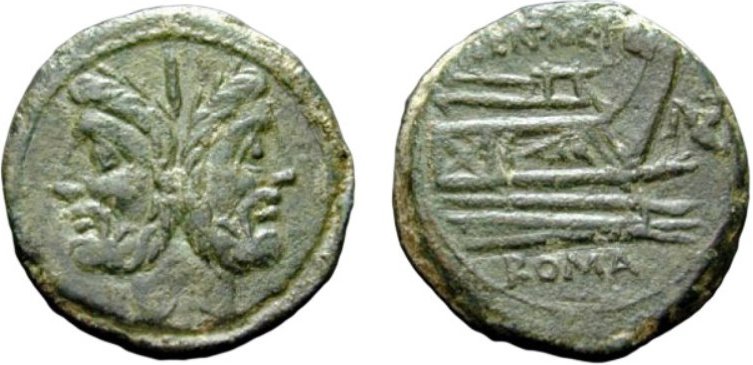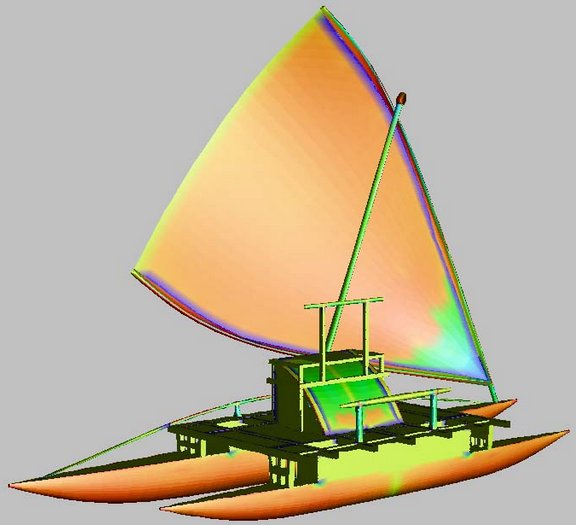79. In order to observe for instance Auriga or the Egyptian X it had to be night. Sirrah (α Andromedae) was visible close to the Full Moon in September 20, when the Sun was at the opposite side of the year, at Alchita (α Corvi) - which therefore could not be seen at that time of the year:
This is hard to perceive from the glyphs above, but assuming heliacal Acrux at the time of Hyadum II had been used by the calendar makers for day 22 in the 7th month (22 / 7 = π), we can then correlate the Julian date for spring equinox with Acrux close to the Full Moon. Or looked at from the other side of the coin, we can correlate Algenib Pegasi close to the Full Moon with day number 260 in the Gregorian calendar (at the time when the Sun was reaching the Pale star in the Southern Cross).
If Auriga was depicted in Ca4-1, then the corresponding nakshatra date (183 days later than the heliacal date) would in the Gregorian calendar have been °December 2 (336 = 153 + 183). The precession had moved the stars ahead with around 4 right ascension days in the Gregorian calendar compared to the time of the Pope. The creator of the C text may have depicted the situation as it was at the time of the Pope and then Ca4-1 would coincide with the nakshatra stars in the 2nd day of °December:
... Ecclesiastically, the equinox is reckoned to be on 21 March (even though the equinox occurs, astronomically speaking, on 20 March (*79) in most years) ...
Yet, the true star positions at the time of rongorongo - updated from the time of the Pope - seem to be indicated by the Egyptian cross in Ca5-14. And the severed trees necessary for building the Argo Navis ship could have been alluded to (pars pro toto) by the mutilated ('castrated') rakau (tree) at Naos: ... He cleared the trunks of their branches and bark, hewed them into shape, and with strong fau ropes he and his men drew them down the valley over cliffs and ravines, seeming to feel it merely light work. Thus King Puna was robbed of his fine aha-tea tree, his mara-uri tree, a toi (Alphitonia) tree, and a hauou (pua, Fagraea) tree; and Hiro spared not the trees sacred to the gods around the marae. He cut down a great tamanu (Callophylum), stripped the trunk of its branches and bark, split it up for planks for the bows of his canoe, and trimmed the branches for outriggers and crossbeams. He cut down a most sacred miro (Thespesia) tree for planks for the after part of his canoe, and he took two tall straight breadfruit trees for planks for the deck houses. Then he went into the woods and cut down straight fau trees (Hibiscus tiliaceus) for paddles and for floor planks, and three slim hutu (Barringtonia) trees for masts. After all this depredation, Hiro and his men helped themselves to wood and thatch and reeds and all other material needed for a shed in which to build the canoe and for rollers to place under it, King Puna not daring to oppose them, as Hiro was too powerful and dangerous to vex ...
Unquestionably the Egyptian X was indicating a profound change. ... Atea then became the wife of Rua-tupua-nui, Source of Great Growth, and they became the parents of all the celestial beings, first the shooting stars, then the Moon and the Sun, next the comets, then the multitude of stars and constellations, and finally the bright and dark nebulae. When this tremendous task had been accomplished Atea took a third husband, Fa'a-hotu, Make Fruitful. Then occurred a curious event. Whether Atea had wearied of bringing forth offspring we are not told, but certain it is that Atea and her husband Fa'a-hotu exchanged sexes. Then the eyes of Atea glanced down at those of his wife Hotu and they begat Ru. It was this Ru who explored the whole earth and divided it into north, south, east, and west ... By looking at the Gregorian calendar dates and then adding 4 because of the precession since the time of Gregory XIII, the reader of the text should perceive an intention to put χ in Argo Navis at Ca5-14. The traditional place for this 'change of sex' of the Sun - no longer striving upwards but falling down (as perceived north of the equator) - was once upon a time defined from heliacal Sirius, in the center of the Egyptian X. Betelgeuze at the right armpit of Orion was at the beginning of the translation and Naos in Argo Navis was where the downward tendency had been completed. …to enter a war canoe from either the stern or the prow was equivalent to a 'change of state or death'. Instead, the warrior had to cross the threshold of the side-strakes as a ritual entry into the body of his ancestor as represented by the canoe. The hull of the canoe was regarded as the backbone of their chief. In laments for dead chiefs, the deceased are often compared to broken canoes awash in the surf ...
At the time of rongorongo Naos could be seen close to the Full Moon in January 19 (384 = 2 * 192). And in July 19 (200 = 384 - 184) the star at the Full Moon was τ Aquilae. High up in the sky was the Eagle and far down at the opposite side was Argo Navis. In Roman times the stars had been positioned 27 days earlier and in 'December 21 (winter solstice) the remains of the ship would have been visible close to the Full Moon.
According to Manuscript E the basic change was from a sea journey to landfall. At the time of rongorongo the stars came a quarter later than when the current constellations had been defined - with the northern spring equinox where the Sun went from Castor (who ruled the winter waters) to Pollux (who brought broad daylight and dried up the land). 26000 years (the anciently adopted duration for the precessional cycle) * ¼ = 6500 = 1842 AD + 4658 BC, when the left foot of Castor had been close to the rising Sun at 0h.
Maro 1 was 37 days earlier than the corresponding date at the time of the Pope:
But the calendar dates of the Pope were 4 days out of tune with the stars: ... When the Pope Gregory XIII updated the Julian calendar he did not revise what had gone wrong before 325 AD (when the Council of Nicaea was held). Thus the stars were still 3-4 days 'out of tune' compared to the calendar ... the Gregorian 'canoe' was 'crooked'. His calendar was not in perfect alignment with the ancient star structure. Because he had avoided to adjust with the effects of the precession between the creation of the Julian calendar and the Council of Nicaea in 325 A.D. [The Julian equinox was in the 3rd month of the year and in its 25th day; 3-25.] And we cannot accept a sudden 4-day jump in the flow of the stars, because this is the only secure ground we have for reading the text. Therefore Naos should be at Ca5-16. The ordinal number of Ga5-16 is 121 and at the time of rongorongo the right ascension day for Naos was *121. The Gregorian calendar had been corrected by the precession of the Sun since the time of the Pope. ... There is a couple residing in one place named Kui and Fakataka. After the couple stay together for a while Fakataka is pregnant. So they go away because they wish to go to another place - they go. The canoe goes and goes, the wind roars, the sea churns, the canoe sinks. Kui expires while Fakataka swims. Fakataka swims and swims, reaching another land. She goes there and stays on the upraised reef in the freshwater pools on the reef, and there delivers her child, a boy child. She gives him the name Taetagaloa. When the baby is born a golden plover flies over and alights upon the reef. (Kua fanau lā te pepe kae lele mai te tuli oi tū mai i te papa). And so the woman thus names various parts of the child beginning with the name 'the plover' (tuli): neck (tuliulu), elbow (tulilima), knee (tulivae). They go inland at the land. The child nursed and tended grows up, is able to go and play. Each day he now goes off a bit further away, moving some distance away from the house, and then returns to their house. So it goes on and the child is fully grown and goes to play far away from the place where they live. He goes over to where some work is being done by a father and son. Likāvaka is the name of the father - a canoe-builder, while his son is Kiukava. Taetagaloa goes right over there and steps forward to the stern of the canoe saying - his words are these: 'The canoe is crooked.' (kalo ki ama). Instantly Likāvaka is enraged at the words of the child. Likāvaka says: 'Who the hell are you to come and tell me that the canoe is crooked?' Taetagaloa replies: 'Come and stand over here and see that the canoe is crooked.' Likāvaka goes over and stands right at the place Taetagaloa told him to at the stern of the canoe. Looking forward, Taetagaloa is right, the canoe is crooked. He slices through all the lashings of the canoe to straighten the timbers. He realigns the timbers. First he must again position the supports, then place the timbers correctly in them, but Kuikava the son of Likāvaka goes over and stands upon one support. His father Likāvaka rushes right over and strikes his son Kuikava with his adze. Thus Kuikava dies. Taetagaloa goes over at once and brings the son of Likāvaka, Kuikava, back to life. Then he again aligns the supports correctly and helps Likāvaka in building the canoe. Working working it is finished ... ... In the Maori tongue the word ra denotes the sun, as it does, with some dialectic changes, throughout Polynesia, and as it did in Babylonia and Egypt. Komaru and mamaru also denote the sun, but are seldom heard. These three names are also applied to a canoe-sail, though one fails to see any connection between the two ...
We should not be surprised to find Egyptian X illustrated in Ca5-14. A strict mechanichal progression from Auriga at the Sun in "April 26 (116 = 4 * 29) to Egyptian X at the Sun in "June 7 (158 = 2 * 79) implies Auriga would have been visible close to the Full Moon in °December 2 (336 = 12 * 28 = 8 * 42) and that 42 nights later the Full Moon would have reached Drus. °January 13 was day number 365 + 13 = 378 (= 9 * 42 and equal to the synodic cycle of Saturn):
|
|||||||||||||||||||||||||||||||||||||||||||||||||||||||||||||||||||||||||||||||||||||||||||||||||||||||||||||||||||||||||||||||||||||||||||||||||||||||||||||||||||||||||||||||||||||||||||||||||||||||||||||||||||||||||||||||||||||||||||||||||||||||||||||||||||||||||||||||||||||||||||||||||||||||||||||||||||||||||||||||||||||||||||||||||||||||||||||||||||||||||||||||||||||||||||||||||||||||||||||||||||||||||||||||||||||||||||||||||||||||||||||||||||||||||||||||||||||||||||||

















